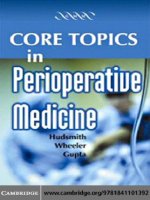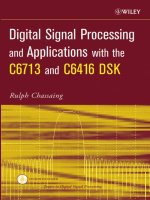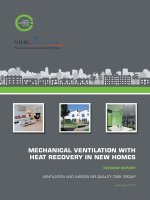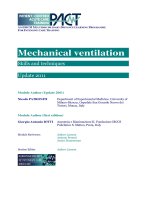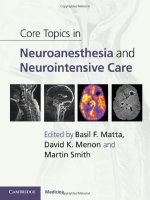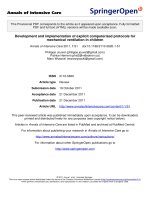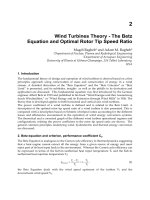Core Topics in Mechanical Ventilation pot
Bạn đang xem bản rút gọn của tài liệu. Xem và tải ngay bản đầy đủ của tài liệu tại đây (10.1 MB, 441 trang )
This page intentionally left blank
Core Topics in Mechanical Ventilation
i
Iain Mackenzie in zero-gravity training for Professor Hawking’s flight, April 26, 2007.
Core Topics in Mechanical Ventilation
Edited by
IAIN MACKENZIE
Consultant in Intensive Care Medicine
and Anaesthesia
CAMBRIDGE UNIVERSITY PRESS
Cambridge, New York, Melbourne, Madrid, Cape Town, Singapore, São Paulo
Cambridge University Press
The Edinburgh Building, Cambridge CB2 8RU, UK
First published in print format
ISBN-13 978-0-521-86781-8
ISBN-13 978-0-511-45164-5
© Cambridge University Press 2008
Every effort has been made in preparing this book to provide accurate and up-to-
date information which is in accord with
accepted standards and practice at the time of publication. Although case histories
are drawn from actual cases, every effort
has been made to disguise the identities of the individuals involved. Never theless,
the authors, editors and publishers can
make no warranties that the information contained herein is totally free from
error, not least because clinical standards are
constantly changing through research and regulation. The authors, editors and
publishers therefore disclaim all liability for
direct or consequential damages resulting from the use of material contained in
this book. Readers are strongly advised to pay
careful attention to information provided by the manufacturer of any drugs or
equipment that they plan to use.
2008
Information on this title: www.cambrid
g
e.or
g
/9780521867818
This publication is in copyright. Subject to statutory exception and to the
provision of relevant collective licensing agreements, no reproduction of any part
may take place without the written permission of Cambridge University Press.
Cambridge University Press has no responsibility for the persistence or accuracy
of urls for external or third-party internet websites referred to in this publication,
and does not guarantee that any content on such websites is, or will remain,
accurate or appropriate.
Published in the United States of America by Cambridge University Press, New York
www.cambridge.org
eBook
(
Adobe Reader
)
hardback
Contents
Contributors page vii
Foreword by Timothy W. Evans ix
Preface xi
Introductory Notes xiii
1. Physiology of ventilation and gas exchange 1
HUGH MONTGOMERY
2. Assessing the need for ventilatory support 21
MICK NIELSEN AND IAIN MACKENZIE
3. Oxygen therapy, continuous positive airway pressure and non-invasive ventilation 32
IAN CLEMENT, LEIGH MANSFIELD AND SIMON BAUDOUIN
4. Management of the artificial airway 54
PETER YOUNG AND IAIN MACKENZIE
5. Modes of mechanical ventilation 88
PETER MACNAUGHTON AND IAIN MACKENZIE
6. Oxygenation 115
BILL TUNNICLIFFE AND SANJOY SHAH
7. Carbon dioxide balance 142
BRIAN KEOGH AND SIMON FINNEY
8. Sedation, paralysis and analgesia 160
RUSSELL R. MILLER III AND E. WESLEY ELY
9. Nutrition in the mechanically ventilated patient 184
CLARE REID
10. Mechanical ventilation in asthma and chronic obstructive pulmonary disease 196
DAVID TUXEN AND MATTHEW T. NAUGHTON
v
Contents
11. Mechanical ventilation in patients with blast, burn and chest trauma injuries 210
WILLIAM T. MCCBRIDE AND BARRY MCCGRATTAN
12. Ventilatory support: extreme solutions 222
ALAIN VUYLSTEKE
13. Heliox in airway obstruction and mechanical ventilation 230
HUBERT TR
¨
UBEL
14. Adverse effects and complications of mechanical ventilation 239
IAIN MACKENZIE AND PETER YOUNG
15. Mechanical ventilation for transport 284
TERRY MARTIN
16. Special considerations in infants and children 296
ROB ROSS RUSSELL AND NATALIE YEANEY
17. Tracheostomy 310
ABHIRAM MALLICK, ANDREW BODENHAM AND IAIN MACKENZIE
18. Weaning, extubation and de-cannulation 331
IAIN MACKENZIE
19. Long-term ventilatory support 372
CRAIG DAVIDSON
20. The history of mechanical ventilation 388
IAIN MACKENZIE
Glossary 404
Index 411
vi
Contributors
Simon Baudouin, FRCP
Senior Lecturer
Department of Anaesthesia and Critical Care
Medicine
Royal Victoria Infirmary
Newcastle-upon-Tyne, UK
Andrew Bodenham, FRCA
Consultant in Anaesthesia and Intensive Care
Medicine
Leeds General Infirmary
Leeds, UK
Ian Clement, PhD MRCP FRCA
Consultant in Anaesthesia and Intensive
Medicine
Department of Anaesthesia and Critical Care
Medicine
Royal Victoria Infirmary
Newcastle-upon-Tyne, UK
Craig Davidson, FRCP
Director, Lane Fox Respiratory Unit
Guy’s and St. Thomas’ NHS Foundation Trust
London, UK
E. Wesley Ely, MD MPH
Professor and Associate Director of Aging
Research
Division of Allergy, Pulmonary, and Critical Care
Medicine
Vanderbilt University School of Medicine
Veterans Affairs, Tennessee Valley Geriatric Research,
Education, and Clinical Center
Nashville, Tennessee, USA
Simon Finney, PhD MRCP FRCA
Consultant in Intensive Care Medicine and
Anaesthesia
Royal Brompton and Harefield NHS Trust
London, UK
Brian Keogh, FRCA
Consultant in Intensive Care Medicine and
Anaesthesia
Royal Brompton and Harefield NHS Trust
London, UK
Iain Mackenzie, DM MRCP FRCA
Consultant in Intensive Care Medicine and
Anaesthesia
John Farman Intensive Care Unit
Addenbrooke’s Hospital
Cambridge, UK
Peter Macnaughton, MD MRCP FRCA
Consultant in Intensive Care Medicine and
Anaesthesia
Plymouth Hospitals NHS Trust
Derriford
Plymouth, UK
Abhiram Mallick, FRCA
Consultant in Anaesthesia and Intensive Care
Medicine
Leeds General Infirmary
Leeds, UK
Leigh Mansfield
Senior Physiotherapist
Department of Anaesthesia and Critical Care
Medicine
Royal Victoria Infirmary
Newcastle-upon-Tyne, UK
vii
List of contributors
Terry Martin, MSc FRCS FRCA
Consultant in Anaesthesia and Intensive Care
The Royal Hampshire County Hospital
Winchester, UK
William T. McBride, BSc MD FRCA FFARCS(I)
Consultant Cardiac Anaesthetist
Royal Victoria Hospital
Belfast, UK
Barry McGrattan, FFARCS(I)
Specialist Registrar in Anaesthesia
Royal Victoria Hospital
Belfast, UK
Russell R. Miller III, MD MPH
Assistant Professor
Division of Critical Care and Pulmonary Medicine
LDS and IMC Hospitals
University of Utah School of Medicine
Salt Lake City, Utah, USA
Hugh Montgomery, MD FRCP
Director, Institute for Human Health and
Performance and Consultant Intensivist
UCL Hospitals
London, UK
Matthew T. Naughton, MD FRACP
Associate Professor of Head, General Respiratory
and Sleep Medicine
The Alfred Hospital
Prahran
Melbourne, Australia
Mick Nielsen, FRCA
Consultant in Anaesthesia and Intensive Care
Southampton University Hospitals NHS Trust
Southampton, UK
Clare Reid, PhD SRD
Research Dietician
Division of Anaesthesia
University of Cambridge
Addenbrooke’s Hospital
Cambridge, UK
Rob Ross Russell, MD FRCPCH
Consultant in Paediatric Intensive Care Medicine
Addenbrooke’s Hospital
Cambridge, UK
Sanjoy Shah, MD MRCP EDIC
Consultant in Intensive Care Medicine
University Hospital Wales
Cardiff, UK
Hubert Tr
¨
ubel, MD
Consultant in Paediatrics
Department of Paediatrics
HELIOS Kilinikum Wuppertal
University of Wittenburg/Herdeche
Wuppertal, Germany
Bill Tunnicliffe, FRCA
Consultant in Intensive Care Medicine and
Anaesthesia
Queen Elizabeth Hospital
Birmingham, UK
David Tuxen, MBBS FRACP MD Dip DHM FJFICM
Associate Professor of Critical Care
The Alfred Hospital
Prahran
Melbourne, Australia
Alain Vuylsteke, MD FRCA
Director of Critical Care
Papworth Hospital NHS Trust
Papworth Everard
Cambridgeshire, UK
Natalie Yeaney, MD FAAP
Consultant Neonatal Intensivist
Addenbrooke’s Hospital
Cambridge, UK
Peter Young, MD FRCA
Consultant in Intensive Care and Anaesthesia
The Queen Elizabeth Hospital
King’s Lynn, UK
viii
Foreword
Bjorn Ibsen, an anaesthetist and intensivist who
practiced for most of his career in Copenhagen,
Denmark, died on 7 August 2007. Ibsen is widely
regarded as the father of Intensive Care Medicine,
the nativity of which occurred in his home city in
1952 during a polio epidemic. Ibsen had trained
in radiology, surgery, pathology and gynaecology
before travelling to Massachusetts General Hospital
in 1949 to gain specialist experience in anaesthesia.
He returned to Copenhagen in 1950 and assumed
a leading role in managing one of the world’s worst
polio epidemics that started only two years later.
Some 2899 cases developed among the population
of two million. Too weak to cough, many patients
succumbed to secretion retention with associated
carbon dioxide retention. Negative pressure ventila-
tion was effectively the only form of support then
available, but Ibsen found that tracheostomy, or
endotracheal intubation combined with the careful
application of intermittent positive pressure venti-
lation administered by relays of doctors, medical
students and others, was an effective means of over-
coming the devastating effects of the disease. In
the end, over 1500 practitioners aspirated secretions
and performed manual ventilation in shifts. Mortal-
ity fell markedly. As a result, the idea that critically
ill patients should be supported in centralized facil-
ities by individuals experienced in their care was
adopted worldwide.
The new specialty emerged in varying phenotypes
according to the history, individual preferences and
expertise of those driving the change. In the United
States, physicians trained in pulmonary medicine
have traditionally also provided critical care. In the
United Kingdom, the base specialty of anaesthesia
has borne the brunt of intensive care provision over
many decades. Only in recent years has the value
of bringing varying expertise to intensive care man-
agement (ICM) from different clinical base special-
ties been recognized more formally. Thus in Aus-
tralia a joint intercollegiate faculty of ICM has been
developed, a model that was to an extent copied
in the UK. Formal training programmes have been
developed, culminating in the UK in ICM being rec-
ognized as a specialty in the year 2000. The emer-
gence of diploma and other examinations designed
to test competencies in intensive care has been rapid.
The strength of national and international special-
ist societies has grown, with associated academic
advancement publicized through congresses and
increasingly in highly cited journals.
Against this background, it has given me great
pleasure to write the foreword for this exciting vol-
ume, expertly conceived and edited by Dr Iain
Mackenzie. The contributors to this book come
from a wide range of clinical and national back-
grounds, thereby reflecting the heterogeneity that is
in many senses the strength of the specialty. More-
over, the content reflects the staggering advances
that have been made during the past 50 years
in the delivery of mechanical ventilatory support.
Even those phenomena which would have been
ix
Foreword
easily recognizable to Ibsen, such as the deliv-
ery of oxygen therapy, have been subjected to sci-
entific evaluation and technological development.
Tracheostomy, used widely in the 1950s polio
epidemic, is now performed at the bedside, an
innovation of which I suspect Ibsen would have
approved. The content of chapters dealing with
sedation, paralysis and analgesia might have been
more familiar to him, but the agents now employed,
the increased understanding of their properties and
the clinical benefits attributable to their avoidance,
where possible, are evidence of the advances made
in this area of pharmacology. The outreach of exper-
tise into the wards in pursuit of the ‘intensive
care without walls’ has been greatly facilitated by
the advent of non-invasive mechanical ventilatory
support.
Finally, the scientific advances in our evaluation
of the effects of mechanical ventilation, the recogni-
tion that it can do harm if applied inappropriately
and the evidence base concerning its use in patients
with a wide variety of primary and secondary lung
pathologies is a truly outstanding achievement that
intensive care medicine can be proud of. I suspect
that Bjorn Ibsen, were he privileged to read this vol-
ume, would feel the same.
Timothy W. Evans, BSC DSC FRCP FRCA FMedSci
Professor of Intensive Care Medicine
Imperial College
London
Consultant in Intensive Care Medicine
Royal Brompton Hospital
London
x
Preface
Respiratory support is recognized to be a key com-
ponent in the resuscitation of acutely ill patients
and, as such, the basics are taught to all those who
seek to acquire life support skills. Following sta-
bilization, the continued provision of respiratory
support, be it in the emergency department, respi-
ratory ward or intensive care unit, is largely taken
for granted. However, as the ARDSnet study has
recently reminded us, the way we manage mechan-
ical ventilation in the medium and long term actu-
ally has a significant impact on patient outcome.
Although the literature is full of the evidence nec-
essary to provide optimal respiratory support, syn-
thesizing this evidence into a cohesive and logi-
cal approach would be an enormous task for one
individual. On the other hand, excellent sections
on respiratory support can be found in the major
textbooks on critical care and indeed the ‘princi-
ples and practice of mechanical ventilation’ is the
sole subject of Martin Tobin’s authoritative tome of
that name. However, these large reference books are
expensive and less than suitable for those who need
a more concise and practical overview of the subject.
This book therefore seeks to fill the gap between
the journals and the major textbooks by bringing
together clear, concise and evidence-based accounts
of important topics in respiratory support, together
with, where necessary, explanations of its physiol-
ogy and pathology. It is hoped, therefore, that this
book will appeal to a very wide audience, and will
make a substantial contribution to the interest in,
and teaching of, the art and science of mechanical
ventilation. In addition, since many of those who
work with patients who require respiratory support
do not have an anaesthetic background, knowledge
particular to this specialty has not been assumed.
I would welcome any feedback so that future edi-
tions of this book can better meet the needs of its
readers.
My colleagues in Cambridge, both nursing and
medical, must be credited with persuading me of
the need for a book such as this, and for that I am
grateful. I am also indebted to the contributors from
around the world who responded so favourably
to my request that they contribute, and then fol-
lowed through with their chapters. Frank McGinn
(GE Healthcare Technologies), Dan Gleeson (Cape
Engineering) and John Wines (Cape Engineering)
kindly supplied me with information about the his-
tories of their respective companies. I have received
assistance in sourcing some of the images from Mr
Pyush Jani and Dr Helen Smith. I am very grate-
ful to David Miller for checking the correctness of
the English, but must accept any blame for any
errors that have crept through. Finally, I would like
to thank Diane, my wife, and Katherine, Rebecca,
Charlotte and Amy, my daughters, for their unfail-
ing support over the last two years while this book
was in production.
Iain Mackenzie
xi
Introductory notes
Physiological notation
Those with a dislike of mathematics will be pleased
to know that none of the equations in this book
need to be memorized. Having said that, though,
understanding the concepts that are encapsulated
by the equations presented will help the reader
enormously in achieving a significantly deeper level
of understanding. As many of the terms in the
equations refer to physiological quantities, physi-
ological notation is used, and therefore being able
to decipher physiological notation will be helpful
P
V
O
2
C Content (mL. dL
−1
)
Fraction
P Pressure (kPa or mm Hg)
Q Volume of blood (mL or L)
S Saturation (%)
V Volume of gas (mL or L)
A Alveolar
a Arterial
b Barometric
c Capillary
c’ End-capillary
D Dead space
E Expired gas
I Inspired gas
s Shunt
t Total
Tidal
v Venous
O
2
Oxygen
CO
2
Carbon dioxide
.
per unit time
_
mean or mixed
Figure 1 Key to physiological notation.
In the example illustrated, the physiological quantity being
referred to is the mixed venous partial pressure of oxygen.
Note also that when blood or gas volume, V and Q
respectively, are expressed ‘per minute’ by placing a dot above
the letter, they then refer to volume/time, or flow. Thus Q,
blood volume, can be converted to
˙
Q, blood flow.
Table 1 In-text notation for commonly used
physiological quantities
Quantity
Correct
notation
In-text
notation
Fractional inspired oxygen
concentration
F
I
O
2
FIO
2
Partial pressure of carbon
dioxide in alveolar gas
PA
CO
2
PACO
2
Partial pressure of carbon
dioxide in arterial blood
Pa
CO
2
PaCO
2
Partial pressure of oxygen in
alveolar gas
PA
O
2
PAO
2
Partial pressure of oxygen in
arterial blood
Pa
O
2
PaO
2
Partial pressure of carbon
dioxide
P
CO
2
PCO
2
Partial pressure of oxygen P
O
2
PO
2
Haemoglobin oxygen saturation
in arterial blood
Sa
O
2
SaO
2
(Figure 1). The reader may be relieved to hear that
formal physiological notation has been completely
avoided in the text because it can sometimes extend
significantly below the text baseline, as in, for exam-
ple, the notation representing the partial pressure of
oxygen in arterial blood:
Pa
O
2
.
However, some quantities are mentioned so often
in the text that to refer to these in words would hin-
der, rather than help, the flow of the text. There-
fore, for the most common of these quantities,
non-physiological notation has been used for
xiii
Introductory notes
Table 2 Pressure conversion
multiply
−→
divide
←−
mm Hg 1.3595 cm H
2
O
kPa 10.197 cm H
2
O
kPa 7.5 mm Hg
Atm 101.325 kPa
Bar 100 kPa
in-text references, as it is in many other publications
(Table 1).
Units
The European convention on units has been main-
tained throughout, using kilopascals (kPa) for
gas pressures rather than millimetres of mercury
(mm Hg), but the conversion factors can be found
in Table 2. However, for clarity the symbol for the
litre, which is usually abbreviated to the lower case
letter ‘l’, has been substituted by the North Amer-
ican convention of using the capital letter ‘L’; thus
‘ml’becomes ‘mL’ and ‘dl’ becomes ‘dL’.
Compound units in clinical practice commonly
use the forward slash ‘/’ as the delimiter to denote
a denominator unit. For example, ‘millilitres per
kilogram’ would be written ‘mL/kg’. In compound
units with only two components, this usage is not
subject to misunderstanding, but in those with
Table 3 Convention for the use of compound
units
Quantity
Common
clinical
notation
Correct
scientific
notation
Millilitres per kilogram mL/kg mL.kg
−1
Microgram per kilogram
per hour
µg/kg/hr µg.kg
−1
.hr
−1
Millilitres per minute mL/min mL.min
−1
Litres per minute L/min L.min
−1
Milliequivalents per litre mEq/L mEq.L
−1
Millimoles per litre mmol/L mmol.L
−1
Kilocalorie per milliliter kcal/mL kcal.mL
−1
Millilitres per hour mL/hr mL.hr
−1
Milligrams per kilogram mg/kg mg.kg
−1
Kilocalories per kilogram kcal/kg kcal.kg
−1
Grams per kilogram g/kg g.kg
−1
Grams per deciliter g/dL g.dL
−1
Micrograms per minute µg/min µg.min
−1
Millilitres per kilogram mL/kg mL.kg
−1
Millilitres per day mL/d mL.d
−1
more than two components, the use of the for-
ward slash is potentially confusing and should be
avoided. The convention in this book, therefore,
is to use the more correct scientific notation. In
this form, the relationship between units is indi-
cated by the superscript power notation, as shown in
Table 3.
xiv
Chapter 1
Physiology of ventilation and gas exchange
HUGH MONTGOMERY
Among its many functions, the lung has two major
ones: it must harvest oxygen to fuel aerobic respira-
tion and it must vent acid-forming carbon dioxide.
This chapter will offer a brief overview of how the
lung fulfills these functions. It will also discuss some
of the mechanisms through which adequate oxy-
genation can fail. A secure understanding of these
principles allows an insight into the way in which
mechanical ventilation strategies can be altered in
order to enhance oxygenation and carbon dioxide
clearance.
Functional anatomy of the lung
The airways
During inspiration, air is drawn into the orophar-
ynx through either the mouth or the nasal air-
way. Nasal breathing is preferred, as it is associated
with enhanced particle removal (by nasal hairs and
mucus-laden turbinates) and humidification. How-
ever, this route is associated with a fall in pharyngeal
pressure. Just as Ohm’s law dictates that voltage is
the product of current and resistance, so pharyngeal
pressure is the product of gas flow and pharyngeal
resistance. A ‘fat apron’around the pharynx because
of obesity may lead to increased pharyngeal com-
pliance, and thus increase the risk of dynamic pha-
ryngeal collapse in such patients. In adults, when
pharyngeal flows exceed 30 to 40 litres per minute,
the work of breathing becomes high and the fall
in pharyngeal pressure too great for the adequate
intake of air: the mouth then becomes the preferred
route for breathing.
The larynx remains a protector of the airway, with
aryepiglottic and arytenoid muscles able to draw
the laryngeal entrance closed like a purse-string and
the epiglottis pulled down from above like a trap
door. In addition, the arytenoid cartilages can swing
inwards to appose the vocal cords themselves, thus
offering an effective seal to the entry of particles or
gases to the airway beneath. Meanwhile, tight occlu-
sion can be achieved during swallowing or to ‘fix’
the thorax during heavy lifting, allowing the larynx
to resist internal pressures of some 120 cm H
2
O.
Laryngeal sensitivity to irritation, causing a cough,
makes the larynx effective at limiting entry of nox-
ious gases or larger particles, while more intense
chemoreceptor stimulation can cause severe laryn-
geal spasm, preventing any meaningful gas flow. In
the anaesthetic room, this can be life-threatening.
When air enters the trachea, it is supported
by anterior horse-shoes of cartilage (Figure 1.1).
However, these are compliant, and tracheal col-
lapse occurs with extrinsic pressures of only 40 cm
H
2
O. Ciliated columnar epithelium yields an
upward-moving mucus ‘escalator’. The trachea then
divides into the right and left main bronchi
(generation 1 airways), and then into lobar and
Core Topics in Mechanical Ventilation, ed. Iain Mackenzie. Published by Cambridge University Press.
C
Cambridge University Press 2008.
1
Nasopharynx
Oropharynx
Epiglottis
Vocal cords
Laryngopharynx
Trachea
iii
b
i
x
a
c
vii
vi
v
iv
viii
ii
ix
b
a
a
c
a
a
c
c
c
b
b
b
b
b
bb
a
aa
a
a
b
c
d
a
b
chapter 1: physiology of ventilation and gas exchange
segmental bronchi (generations 2–4). The right
main bronchus is wider and more vertical than the
left, and is thus the ‘preferred’ path for inhaled
foreign bodies. Cartilaginous horse-shoe supports
in the upper airways give way to plates of cartilage
lower down, but all will collapse when exposed to
intrathoracic pressures of >50 cm H
2
O (or less in
situations in which the walls are diseased, such as
in chronic obstructive pulmonary disease or bron-
chomalacia).
Successive division of bronchi (generations 5–11)
yield ever-smaller airways (to about 1 mm diam-
eter), all of which are surrounded by lymphatic
and pulmonary arterial branch vessels. They are
supported by their cartilaginous plates and rarely
collapse because intra-bronchial pressure is nearly
always positive. So long as there is patency between
alveoli and bronchi, even forced expiration allows
Figure 1.1 Gross and microscopic anatomy of the respiratory tract.
Inset i: Conventional microscopy view of the surface of the ciliated epithelium of the trachea showing cells bearing cilia adjacent to
cells which appear flat, but which in fact bear microvilli. Photomicrograph courtesy of the Ernest Orlando Lawrence Berkeley
National Laboratory, California.
Inset ii: Transmission electron microscope image of a thin section cut through the bronchiolar epithelium of the lung showing
ciliated columnar cells (a) interspersed by non-ciliated mucous-secreting (goblet) cells (b). Slide courtesy of Dr Susan Wilson,
Histochemistry Research Unit, University of Southampton.
Inset iii: Section of bronchus lined with pseudo-stratified columnar epithelium (a), and surrounded by a ring of hyaline cartilage (b).
The presence of sero-mucous glands (c) differentiates this from a bronchiole. This section also contains an arteriole (d). Bar = 250
microns. Slide reproduced with permission. Copyright
C
Department of Anatomy and Cell Biology, University of Kansas.
Inset iv: Tiny islands of hyaline cartilage (a) confirm that this is bronchus rather than bronchiole, and adjacent is a pulmonary vein
(b). Bar = 250 microns. Slide reproduced with permission. Copyright
C
Department of Anatomy and Cell Biology, University of
Kansas.
Inset v: The absence of cartilage and sero-mucous glands means that this is a bronchiole, with a surrounding cuff of smooth muscle
(a). Bar = 25 microns. Slide courtesy of Dr Susan Wilson, Histochemistry Research Unit, University of Southampton.
Inset vi: A small bronchiole (a) surrounded by smooth muscle (b). Bar = 25 microns. Slide courtesy of Dr Susan Wilson,
Histochemistry Research Unit, University of Southampton.
Inset vii: An alveolus lined by thin flat type I pneumocytes (a) and cuboidal, surfactant-secreting type II pneumocytes (b), with an
integral network of fine capillaries (c) embedded within the alveolar walls. The lumen of the alveolus contains a large alveolar
macrophage (d). Bar = 25 microns. Slide courtesy of Dr Susan Wilson, Histochemistry Research Unit, University of Southampton.
Inset viii: Scanning electron microscope image of the alveolar honeycomb. Photomicrograph courtesy of the Ernest Orlando
Lawrence Berkeley National Laboratory, California.
Inset ix: This photomicrograph shows the fine network of capillaries that enmesh the alveoli.
Inset x: Transmission electron microscopic image of alveolar cells, showing large cuboidal type II pneumocytes (a) packed with
vesicles containing surfactant (b). Nearby alveolar capillaries containing red blood cells can be seen (c). Photomicrograph courtesy
of the Rippel Electron Microscope Facility, Dartmouth College, New Hampshire.
sufficient gas flow to maintain intra-bronchial pres-
sures to a level above intrathoracic pressures.
Bronchioles (generations 12–16) lack cartilagi-
nous support, but are held open by the elastic
recoil of the attached lung parenchyma, making
airway collapse more likely at lower lung volumes.
The cross-sectional area of these very small distal
airways, and their very thin walls, makes airway
resistance at this level almost nil in the absence
of contraction (bronchoconstriction) of the wall’s
smooth muscle cells. Subsequent respiratory bron-
chioles (generations 17–19) have increasing num-
bers of gas-exchanging alveolar sacs in their walls;
these bronchioles are anchored open under tension
from surrounding parenchyma. Each of 150 000 or
so ‘primary lobules’representsthe distal airway sub-
tended by a respiratory bronchiole. Distally (gener-
ation 20–22), alveolar duct walls give rise to some
3
chapter 1: physiology of ventilation and gas exchange
20 alveolar sacs, containing one third of all alveolar
gas. The terminal alveolar sacs (generation 23) are
blind-ending.
The Alveoli and Their Blood Supply
Each lung may contain up to half a billion alve-
oli, which are compressed by the weight of over-
lying lung and are thus progressively smaller in
a vertical gradient. Alveolar gas can pass between
adjacent alveoli through small holes called ‘the
pores of Kohn’. The pulmonary capillaries form a
rich network enveloping the alveoli, with the alve-
olar epithelium closely apposed to the capillary
endothelium. The other surface of the capillary is
embedded in the septal matrix.
Blood delivered into the pulmonary arteries from
the right ventricle flows at a pressure less than 20%
of that of the systemic circulation. With near identi-
cal blood flows, one can infer that pulmonary vas-
cular resistance is correspondingly five- to sixfold
lower than systemic. Working at lower pressure, the
pulmonary arterial wall is correspondingly thinner,
while the pulmonary arteriolar wall contains vir-
tually no smooth muscle cells at all. Capillaries in
dependent areas of the lung tend to be better filled
than areas higher up (due again to gravitational
effects), while lung inflation compresses the capil-
lary bed and increases effective resistance to blood
flow. Blood flows across severalalveolar units before
passing into pulmonary venules and thence to the
pulmonary veins.
Pulmonary mechanics
Air enters the lung in response to the generation of
a negative
1
intrathoracic pressure (in normal venti-
lation, or in negative pressure and cuirass mechan-
ical ventilation), or to the application of a positive
airway pressure (in positive pressure ventilation
modes). Work is thus performed in overcoming
both resistance to gas flow and elastic tension in the
1
Also referred to as subatmospheric.
lung tissue during the thoracic expansion of inspi-
ration. A small quantity of energy is also dissipated
in overcoming lung inertia and by the friction of
lung deformation.
Elasticity and the lung
The lung’s elasticity derives from elastin fibres of
the lung parenchyma, which accounts for perhaps
one third of elastic recoil, and from the surface ten-
sion of the fluid film lining the alveoli. When fully
collapsed,
2
the resting volume of the lung is con-
siderably smaller than the volume it occupies when
fully expanded in the chest cavity. Fully expanded,
the elasticity of the lungs generates a subatmo-
spheric pressure in the pleural space of about
−5.5 cm H
2
O (Figure 1.2). At peak inspiration,
when the thoracic cage is maximally expanded, this
pressure may fall to nearly −30 cm H
2
O.
It is worth giving some thought to the issue of
surface tension forces within the lung. The pressure
within a truly spherical alveolus (P
a) would nor-
mally be calculated as twice the surface tension (T
s
)
divided by the alveolar radius (r):
P
A
=
2 × T
s
r
. (1.1)
This equation tells us that if surface tension were
constant, the alveolar pressure would be inversely
proportional to the alveolar radius. In other words,
alveolar pressure would be higher in alveoli with
a smaller radius (Figure 1.3). If this were the case,
it would mean that smaller alveoli would rapidly
empty their gaseous content into larger adjacent
alveoli and collapse. Taken to its logical conclusion,
all of the alveoli in a lung would empty into one
huge alveolus.
Fortunately, surface tension is not constant
because of the presence of a mixture of phospho-
lipids
3
and proteins
4
that floats on the surface of
2
For example, when removed from the chest at autopsy.
3
Mainly phosphatidylcholine, commonly referred to as lecithin.
4
Surfactant proteins A to D, often referred to as SP-A, SP-B,etc.
4
chapter 1: physiology of ventilation and gas exchange
Figure 1.2 Negative pleural pressure.
A: The respiratory system can be compared to a rubber balloon (the lungs) placed inside a glass jar (the chest cavity) with the
space between the outside of the balloon and the inside of the jar representing the pleural space.
B: The opening of the glass jar is sealed over by the rubber balloon, sealing the space between the outside of the balloon and the
inside of the jar from the atmosphere.
C: As residual gas in this space is evacuated the pressure in the ‘pleural space’ drops below atmospheric and the balloon expands.
D: Once all the gas in the ‘pleural space’ is evacuated the ‘lung’ is completely expanded to fill the ‘chest cavity’. The pressure inside
the ‘lung’ remains atmospheric while the pressure in the pleural space is subatmospheric (negative).
r
2r
AB
Figure 1.3 Alveolar instability with constant surface tension.
A: With constant surface tension (T
s
), the alveolar pressure in
the smaller alveolus is
2×T
s
r
and the pressure in the larger
alveolus is
2×T
s
2r
, which means that whatever the values of T
s
and r, the pressure is only half that in the larger alveolus.
B: Under these circumstances, gas flows from the smaller
alveolus (higher pressure) to the larger alveolus (lower
pressure).
the fluid lining the alveoli (the surfactant; see
Figure 1.4), which reduces the surface tension in pro-
portion to the change in the surface area: the smaller the
surface area of the alveolus, the greater the reduc-
tion in surface tension. This means that gas in fact
tends to flow from larger to smaller alveoli, produc-
ing homogeneity of alveolar volume and stabilizing
the lung. One other major advantage of this effect
on fluid surface tension is that the lung’s compli-
ance is significantly increased, reducing the negative
pressure generated by the lung in the pleural space.
This consequently reduces the hydrostatic pressure
gradient between the inside of the pulmonary capil-
laries and the pulmonary interstitium, minimizing
the rate at which intravascular fluid is drawn from
the capillaries. Lack of surfactant, for instance in
intensive care patients with acute lung injury, thus
tends to cause alveolar collapse and reduce lung
compliance, which substantially increases the work
of breathing.
As the chest expands during inspiration, intra-
alveolar pressure falls to little more than −1cm
H
2
O, causing the air to flow down a pressure gra-
dient from the nose and mouth to the alveoli.
It is notable just how modest the intra-alveolar
pressures have to be to cause gas to flow in and
5
Air
Surfactant phospholipids
Lipid tails (hydrophobic)
Glycerol-based ‘torso’
Phosphoric acid ‘neck’
Hydrophilic ‘head’
Alveolar epithelium
Hypophase
Surface-associated phase
Air
Surfactant phospholipids
Alveolar epithelium
Hypophase
Surface-associated phase
A
B
C
Figure 1.4 Surfactant.
A: Surfactant phospholipids are composed of two hydrophobic fatty acid tails joined to a hydrophilic head via glycerol and
phosphoric acid. The most common phospholipid in surfactant is phosphatidylcholine, while the hydrophilic head is choline. Fatty
acids in which all the bonds between adjacent carbon atoms are single are said to be ‘saturated’, and are physically flexible,
allowing the molecule to pack in closely to its neighbour. Fatty acids in which one or more of the carbon–carbon bonds are double
are said to be ‘unsaturated’. These double bonds impart an inflexible angulation to the molecule, which prevents it from packing
closely. The most effective phosphatidylcholine molecules are ones in which both fatty acid tails are saturated (‘di-saturated’), such
as dipalmitoyl-phosphatidylcholine.
B: The surfactant phospholipids float on the surface of the fluid lining the alveoli, with their hydrophilic heads in contact with the
aqueous phase and their hydrophobic tails sticking in the air.
C: Expiration reduces the surface area of the alveolus, squeezing the bulkier and less effective phospholipids into the
surface-associated phase. The remaining phospholipids, being predominantly disaturated, are more effective at reducing the
surface tension and, as their concentration is increased, the surface tension is reduced further.
chapter 1: physiology of ventilation and gas exchange
Atmospheric pressure
Proximal airway
Alveolus
Interstitium
Pleural cavity
Transmural pressure
Pressure
Inspiration
Expiration
Figure 1.5 Absolute pressures along the airway during inspiration (blue) and expiration (green). During inspiration (blue) there is a
pressure gradient between the proximal airway that is at atmospheric pressure at the mouth and the pleural space that is reversed
during expiration.
out of the lung during normal breathing, a fac-
tor to be considered when comparison is made
with mechanical modes of ventilation. Of course,
much higher pressures can be achieved. Strain-
ing against a closed glottis, for example, can raise
alveolar pressure to 190 cm H
2
O, while maximal
inspiratory effort can reduce pressure to as low as
−140cmH
2
O.
Transmural pressure is defined as the difference
between the pressure in the pleural cavity and that in
the alveolus (Figure 1.5). To remain open, alveolar
pressure must be greater than that of the surround-
ing tissue. During inspiration, intra-pleural pres-
sure falls to a greater degree than alveolar pressure,
and the transmural pressure gradient thus increases.
Over the range of a normal breath, the relationship
between transmural pressure gradient and lung vol-
ume is almost linear. This relationship holds true for
the alveoli, but the lower down in the lung the alve-
oli are, the more the distending transmural pressure
gradient is counteracted by the weight of lung tissue
compressing the alveolus from above. For this rea-
son, dependent alveoli tend to have a smaller radius
and are more likely to collapse.
The ‘expandability’ of the lung is known as its
compliance. A high compliance means that the lung
expands easily. The compliance of the normal res-
piratory system (lungs and thoracic cage) in upright
humans is about 130 mL.cm H
2
O
−1
, while that of
the lungs alone is roughly twice that value, demon-
strating that half of the work of breathing during
health simply goes into expanding the rib cage.
When a positive pressure is applied to the respira-
tory system, such as during positive pressure venti-
lation, gas immediately starts to flow into the lungs,
which then expand. However, while gas is flowing,
7
chapter 1: physiology of ventilation and gas exchange
Pressure, P
0
Pressure, P
1
Pressure, P
2
Volume delivered, V
Volume delivered, V
‘Lungs’
Low compliance proximal airways
High compliance alveoli
Resistance
A
B
C
Figure 1.6 Two-compartment model of static and dynamic compliance.
A: In this model the ventilator is represented by the syringe, which is attached to the two-compartment lung model that consists of
a low-compliance proximal chamber (the proximal airways) separated from a high-compliance distal chamber (the alveoli) by a
fixed resistance. Prior to the onset of gas delivery (inspiration), the whole system is at the same pressure: P
0
.
B: Gas is delivered to the lung model with a moderate increase in gas pressure in the syringe (the ventilator) and proximal
chamber (the large airways) but with only a small increase in pressure in the distal chamber (the alveoli) as gas seeps through the
resistance. Compliance measured just prior to the end of inspiration would be given by V/P
1
.
C: Without the delivery of any further gas from the ventilator, the volume of the distal chamber continues to increase until the
pressure in both chambers becomes the same. As gas redistributes from the high-pressure proximal chamber to the low-pressure
distal chamber, the gas also expands slightly. At equilibrium, the compliance is given by V/P
2
, which is larger than that calculated
in B because P
2
< P
1
.
the proximal airway pressure must be higher than
alveolar pressure,
5
and the steepness of this pres-
sure gradient will depend on the resistance to gas
flow. Therefore, during inflation the ratio of vol-
ume change to inflating pressure (known as dynamic
compliance) is lowered by the effect of resistance
5
Otherwise gas would not flow.
to gas flow (Figure 1.6). At the end of inspiration,
the proximal airway pressure immediately falls as
gas delivery ceases (and with it, the resistive con-
tribution to airway pressure) and then falls a little
further as gas is redistributed from low-compliance
proximal airways to high-compliance alveoli. There
is also an associated small increase in total lung vol-
ume. The percentage of total change in lung volume
8
chapter 1: physiology of ventilation and gas exchange
Pressure
I EIP
Peak inspiratory pressure, P
pea
k
Initial plateau pressure, P
plat-i
Plateau pressure, P
plat
Time
Figure 1.7 A pressure and time profile during volume-targeted
constant flow mechanical ventilation.
For a delivered tidal volume of V mL, dynamic compliance is
given by V/P
peak
and static compliance is given by V/P
plat
. The
difference between P
peak
and P
plat-i
is due to airways
resistance, while the difference between P
plat-i
and P
plat
is due
to inter-alveolar gas redistribution (pendelluft) and hysteresis.
when held at a set pressure is known as the lung’s
static compliance. Put another way, if a set volume
of air is used to inflate a lung, pressure will rise
accordingly, but (with lung volume held) will then
gradually fall by some 25% or so (Figure 1.7). This
effect is one of the contributing factors to a phe-
nomenon known as hysteresis in which the lung
traces a different path on an expiratory plot of lung
pressure (x-axis) against volume (y-axis) than it
does during inflation (Figure 1.8). Other contrib-
utors to hysteresis include the opening of previ-
ously collapsed alveoli during inflation,
6
displace-
ment of lung blood at higher lung volumes, ‘stress
relaxation’ of lung elastic fibres, and perhaps most
importantly, the surface-area-dependent effect of
surfactant in reducing surface tension. In practice,
what this means is that at any given inflation pres-
sure, lung volume will be greater during expiration
than inspiration because the lungs are resistant to
accepting a new higher volume, and then resistant
to giving it up again.
6
Commonly referred to as alveolar ‘recruitment’.
Pressure (cm water)
Volume (ml)
End-expiratory lung volume
End-inspiratory lung volume
Hysteresis
Inspiration
Expiration
Figure 1.8 Inspiratory and expiratory volume/pressure loop
during positive pressure inflation showing the phenomenon of
hysteresis.
During inspiration (blue) of the lung, both pressure (x-axis)
and volume (y-axis) increase, but this is non-linear. During
expiration, the volume/pressure curve traces a different path.
The area subtended by the inspiratory and expiratory paths
represents the energy consumed by hysteresis.
LUN G VOLUMES
Total lung capacity (TLC) is the volume of intrapul-
monary gas at the end of a maximal inspiration.
Functional residual capacity (FRC) is the volume
remaining in the lungs at the end of normal expi-
ration that rises with body size (as determined by
height) and on assumption of the upright pos-
ture. In mechanically ventilated subjects, FRC is
also known as the end-expiratory lung volume
(EELV). FRC is reduced when the lung is extrinsically
compressed (from pleural fluid or abdominal dis-
tension), when lung elastic recoil is increased, or
when the lungs are fibrosed.
Gas exchange
OXYGEN UPTAKE
Oxygenation is accomplished through the diffu-
sion of oxygen down its partial pressure gradient
(Box 1.1) from the alveolus, across the alveolar
epithelium, and thence across the closely apposed
capillary endothelium to the capillary blood, a
distance of <0.3 µm. The capacity to transfer oxygen
from alveolus to red blood cell is determined by
(1) the surface area for diffusion and (2) the ratio
9

